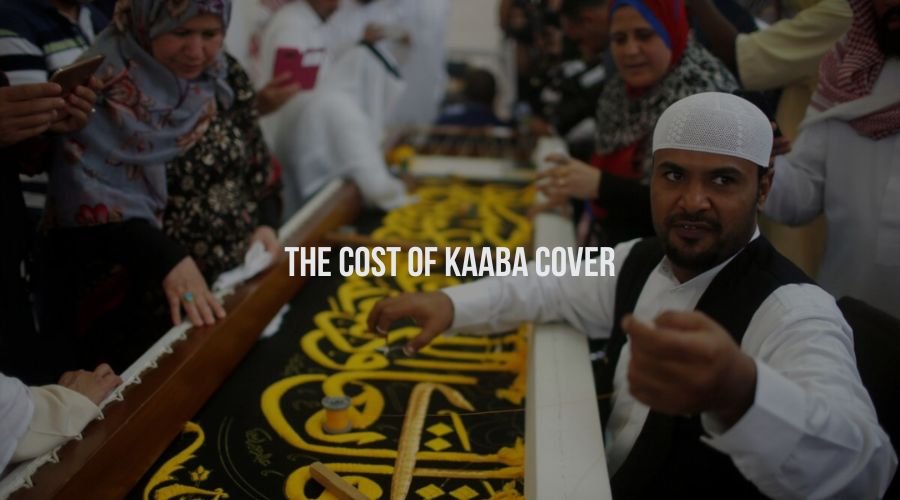As you go closer to the Holy Kaaba in Masjid Al Haram, the Great Mosque of Makkah, Saudi Arabia, you can’t help but notice a distinct and pleasant smell that surprises you. As you approach the House of Allah SWT, the scent of a heavy, potent perfume becomes more overpowering. The exquisite silk garments known as the Kaaba Kiswa that envelop the Holy Kaaba are the source of this fragrance.
The Kaaba opens thirty days prior to the Hajj and thirty days prior to Ramadan each year. On the ninth day of Dhul Hajj, when pilgrims ascend Mount Arafat, the Kiswah is, however, changed yearly.
Everything you need to know about Kaaba Kiswa and its importance in Islam is provided here.
What is Kiswah?
The word “Kiswah,” also referred to as the “Ghilaf,” literally means robe. The Kiswah, a black fabric covering the Holy Kaaba, was altered on the ninth day of Dhul Hajj. It is made of cotton and silk and is embellished with lines from the Holy Quran. The Kaaba Kiswa consists of a gold band with words from the Quran written in beautiful calligraphy.
Every year, the Kaaba cover is swapped out with a white fabric that symbolises the pilgrims’ Ihram at the Hajj, the fifth pillar of Islam.
By the end of the ninth day of the Hajj, a brand-new Kaaba cover takes the place of the Holy Kaaba’s temporary cover. Additionally, copper rings are used to secure the Holy Kaaba’s new cover to the stones at its marble base. The ancient one, on the other hand, is broken into little pieces and either sold or given as gifts to pilgrims and well-known religious figures from all over the world.
What is written on the Kaaba Cover?
The Holy Kaaba’s cover has a beautiful design. Most people are curious, nonetheless, about the condition of the exquisitely carved Arabic calligraphy in golden hue. Millions of Muslims go from all over the world to the Holy Kaaba each year to perform the Umrah or Hajj. Each of the 47 garment strips used to make the Kaaba Kiswa is about 14 cm long and 101 cm in width.
On the black side of the Holy Kaaba cover, three horizontal rows are implanted together. The following is stated in each row:
First Row: Ya Allah’s two names are inscribed there. “Ya Mannan,” which means “Tremendous in Giving,” and “Ya Hannan,” which clearly means “Merciful towards servants.”
Second Row: “La Illaha Illa Allah Muhammad Ur Rasulullah” (means “There is no God but Allah, and Muhammad PBUH is His last messenger”).
Third Row: “SubhanAllah hi Wabihamdi hi SubhanAllah hil Azeem,” in the third row, signifies that “Allah is perfect and deserves all praise.” Allah is the greatest; He is devoid of all imperfections.
As previously mentioned, important words from the Holy Quran are embroidered in gold on the majority of the Kaaba Kiswa. The following passage from Hajr al-Aswad and Rukan Yamani is imbedded in the side of the Kiswah:
“In the name of God. It is accurate. Furthermore, honouring Allah’s emblems comes from a place of deep devotion in one’s heart.
The Kaaba Kiswa Throughout The Time
Islamic tradition states that the first person to cover the Holy Kaaba was Prophet Ismail (AS). But as Islam grew, it became a badge of respect for any king wishing to assert their control over Makkah, Saudi Arabia, to supply the cloth for Kiswah. The following illustrates the evolution of the Kaaba Kiswa’s colours and materials over time:
- During the time of Prophet Muhammad (PBUH), Yemeni cloth with red and white stripes was used to make Kaaba Kiswa.
- Hazrat Abu Bakr (RA), Hazrat Umar (RA), and Hazrat Usman (RA) Caliphate: Egyptian cloth dyed white was used to make the Kaaba cover.
- During the reign of Abdullah bin Zubair (RA), the Holy Kaaba was covered with a red brocade-coloured Kaaba Cover.
- During the Seljuk era, the Holy Kaaba was covered with a Kaaba kiswa that had a brownish-gold hue.
- During the reign of Abbasid Caliph Al-Nasir, the Holy Kaaba was draped with green coloured cloth.
- From the time of Caliph Al-Nasir until now: Nowadays, a black silk cloth embroidered with gold is used as the Kaaba Kiswa. Italy is where the pure silk fabric is imported.
The Kiswah in the Era of Prophet Muhammad (PBUH)
The Qurayshite authorities forbade Prophet Muhammad (PBUH) and his companions from covering the Holy Kaaba prior to the capture of Makkah. As a result, the ancient Kaaba Kiswa was destroyed in a fire and replaced with a Yemeni cloth with red and white stripes after Prophet Muhammad (PBUH) captured the Makkah region.
Hazrat Abu Bakr (RA), Hazrat Umar (RA), and Hazrat Usman (RA) covered the Holy Kaaba, however, with a pristine white Egyptian cloth known as “qibati” during their Caliphate.
The Kaaba is Covered with Various Materials, Fabrics, and Colours
As far as we are aware, 650 kg (or 47 pieces) of natural silk that are imported from Italy are used in the production of Kaaba Kiswa. Every length of silk is 14 metres by 98 centimetres. To assist in maintaining the integrity of the silk top, the Kiswah’s interior is composed of a sturdy cotton lining.
Additionally, it features a 46-meter-long and 95-cm-wide belt segment that holds the Kaaba Cover in place. The Quranic verses are stitched on this belt, which is constructed from sixteen pieces of silk material. Moreover, the Kiswah’s Quranic phrases are embossed using over 120 kilograms of German-sourced silver and gold threads.
The Kiswah also includes Sitara, the Holy Kaaba’s curtain. In the year 819 Hijri, the Holy Kaaba’s gate was initially covered with a curtain. The Sitara, which has multiple verses stitched in silver thread and gold plating, is a symbol of devotion and genuine faith.
The Cost of Making Kaaba Cover
The cost of creating the black silk Kaaba Kiswa, which covers the Kaaba, which is considered the holiest spot in the world for Muslims, is approximately SAR 17,000,000 (4,500,000 USD), or almost Rs 33.4 crore!
The 658 square metre Kaaba cover is constructed from 670 kilograms of raw silk that has been dyed black. There are 120 kg of gold and 100 kg of silver thread used in the needlework. Gold-plated threads are used to stitch Quranic texts onto the black fabric.
In preparation for the yearly Hajj trip, the Mecca authorities have ceremoniously raised the lower portion of the Kiswa cpover over the Kaaba this year as the Muslim world observes the start of the new Islamic month of Dhu al-Hijjah.
The lowest portion of the Kaaba Kiswa covering was lifted during the initial moments of Wednesday’s Dhu al-Hajjah month, according to the Al Arabiya portal. The procedure is typically completed a few days before the Hajj before pilgrims travel to the sacred locations to start their journey.
Dr. Abdul Rahman Al-Sudais, the General President of the Prophet’s Mosque and the Holy Mosque, led more than fifty men from the King Abdul Aziz Complex to the Kaaba on Wednesday in order to replace the lowest portion of the Kaaba’s covering.
The Kiswah, or drapery covering the sacred edifice overlaid with silky black cloth embroidered with gold, is changed annually by the gatekeepers of the Kaaba. This is an intricate and delicate task.
On the second day of the Hajj, the Kaaba cover will be changed under the direction of Sheikh Dr. Abdulrahman bin Abdulaziz Al-Sudais, the President of the Prophet’s Mosque and the Holy Mosque.
Saudi Arabia will only permit a restricted number of people to make the Hajj this year owing to the ongoing COVID-19 coronavirus pandemic risk.
Some of the best calligraphers and painters in the Muslim world create the Kaaba cover, one of the most significant ornaments in the House of God.
Raising the Kaaba’s cover twice a year has been a long-standing custom that has been accepted by the community.




